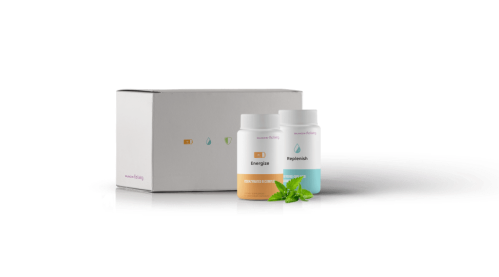Our editors independently select these products. Making a purchase through our links may earn Well+Good a commission
Your period is the single biggest factor in how your skin looks—here’s what to know
It's all about syncing cycles.

The first rule I ever learned as a beauty editor was this: Your skin turns over on a 28-day cycle, similar to the timeframe of your period. The first thing I ever learned about periods was a grammar rule, but it still holds: The period comes at the end, because it has the last word.
Throw those two bits of wisdom in a paper bag and give ‘em a shake and you have something resembling the following: Your menstrual cycle has the final say in what your skin looks like. Period.
Or maybe an ellipses, rather…because it doesn’t have to. Since your body and your skin share a similar clock, by understanding what happens to your skin while simultaneously understanding the effects that your hormonal cycle can have on your body, you can finally outsmart “that time of the month” to get glowing skin on a 365-day loop.
Keep scrolling to find out what you need to know about periods and how to keep them from wrecking your skin.

What you need to know about skin and hormonal cycles
So, first: A biology lesson. Skin cells grow and turn over approximately every four weeks: with new growth in the epidermis pushing up older cells that need to be sloughed off via exfoliation. Menstrual cycles also occur within that time frame, causing estrogen, progesterone, and testosterone levels to fluctuate and have different effects on your skin. There are four phases of the menstrual cycle: The follicular phase (day one of your period up to ovulation), then ovulation, the luteal phase (post-ovulation up to the start of the period), and finally the menstrual phase.
“Estrogen affects wrinkles, skin thickness, and hydration. A drop in estrogen around day five causes skin to become dull, sensitive, dry, and dehydrated,” explains Michelle Yagoda, MD, a New York City facial plastic surgeon. “Around ovulation, both estrogen and testosterone levels rise leading to a healthy glow, but after that, progesterone levels keep going up [until they top out] a week before your period.”
Typically, this is the point at which we talk about “period skin,” with many women experiencing breakouts around the chin area. “This happens in two ways,” says women’s hormone expert (and Well+Good Council member) Alisa Vitti, who’s a pioneer of female biohacking and the best-selling author of WomanCode. “The excess estrogen causes estrogen dominance and skin inflammation, and the extra testosterone plays on your sebaceous glands to produce more oil.”
But rogue pimples aren’t the only casualty: Many women notice a visible difference in the plumpness of skin. “Estrogen and progesterone levels affect the thickness of the skin differently each phase of your cycle,” Vitti says. “During follicular phase and especially during ovulation, high levels of estrogen thickens and protects the epidermis by boosting collagen production give you that famed ‘ovulation glow.’”
After the come-hither skin effect goes away, however, estrogen levels drop during your period, so the skin gets thinner. “Obviously when you’re on your period, your estrogen levels are low, so your skin feels drier and there’s bloating,” says Jeana Chung, vice president of marketing for hormonal-centric skin-care line Knours. And when moisture levels drop, you produce less collagen, making your skin looks less taut.

Yes, birth control gets in the way
Now, historically one of the ways to stop this from happening is by regulating the hormones, which is why many dermatologists have frequently turned to the pill as a way to stop hormone fluctuation, and thereby keep skin from freaking out. “Acne often comes from a hormonal imbalance,” explains Mona Gohara, MD, a Danbury, CT, dermatologist. “Birth control regulates this even slight imbalance and lessens breakouts.”
It does this by keeping you from ovulating and controlling all of those spikes in estrogen that happen during the four phases you go through every month. When you’re taking synthetic hormones, your estrogen levels don’t rise midway through your cycle (which causes an egg to drop into place)—so you don’t ovulate.
As of late, however, skin-care gurus have begun realizing that by simply using the skin’s natural cues—the thickening, excess oil production, and so on—you’re able to optimize a skin-care routine so that exfoliation, moisturization, and treatment can occur at the right time of the month, minimizing irritation and maximizing efficacy.

So how do you deal?
According to experts, the most important thing to consider is what your body is telling you it needs. For Vitti, she sticks to a regimen that goes something like this: post-period during the first half of the cycle, she likes to get a facial to perform extractions that are lingering from the uptick in sebum around menstruation and perform exfoliation with some sort of chemical exfoliator. During ovulation and the first half of the luteal phase, she keeps it simple, using gentle toners, plus dry brushing to help the lymph offset the estrogen spike. Finally, during menstruation, she’ll focus on hydration with masks and anti-inflammatory ingredients.
Obviously, everyone’s cycle is completely different.“The way that we talk about hormonal changes and skin conditions is we encourage everyone to hear their own body rhythm and to really understand how their own body works and to respect that,” explains Claire Zhao, CEO of the hormonal-focused beauty brand Amareta, which has products dedicated to help during the luteal and menstrual phases (clarifying products and moisturizing products, respectively).
Knours, likewise, has an ingenious double-duty mist that works two ways. “When you’re on your period, and you need those extra vitamins to your skin, you shake it so the bottom layer aloe vera water combines with extra ingredients like rose liquid, green tea, and jojoba oil to help put your dull and tired skin at ease,” explains Chung. When your skin is more acne-prone, you don’t shake it so that you don’t get those extra hydrators.
So it comes down to this: During the hormonal cycle, your skin experiences unique conditions of excess oil and excess dryness, depending on where your hormones are charting. By targeting those with forward-thinking products or by tailoring your existing regimen to be optimized for exfoliation during sebum-spiking times and moisturization during drier times, you can finally stop your period from dictating how you feel about your skin and find yourself in the loop.
Shop Hormonal-Focused Beauty

Knours Double Duty Mist $36

Beauty Me The One $20

Flo Living Supplement Kit $249 for 2 month supply

Amareta Earth Mother Mask $46
If you’re curious about how to track your period, there are all sorts ways, including your FitBit and even a prescription box.
Sign up for the Well+Good SHOP Newsletter
Get exclusive deals on wellness, beauty, fitness, and food products that have been hand-picked by our editors.
Got it, you've been added to our email list.










